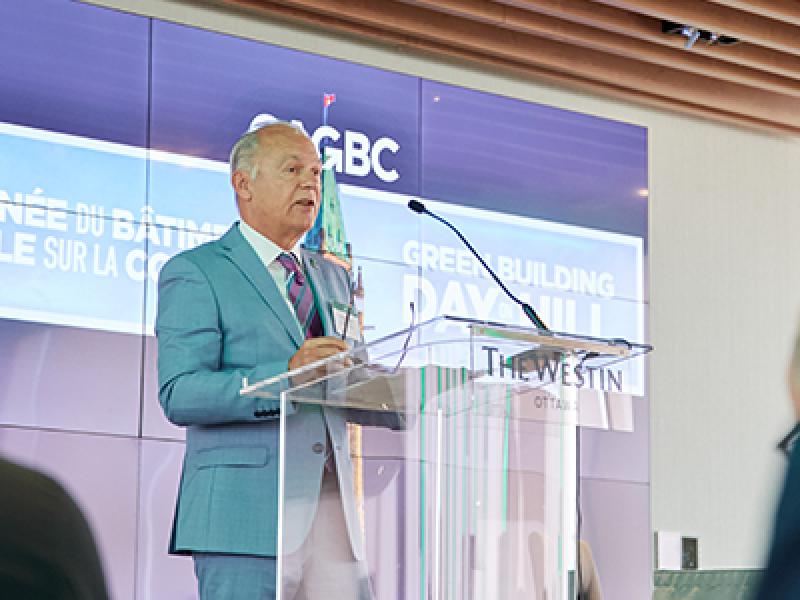Ready for the next generation of certification? On April 28, we took an important step forward: Registration opened for the latest version of Leadership in Energy and Environmental Design® rating system or LEED®.
With LEED v5, this powerful platform for sustainability achievement is reimagined, unlocking new ways to deliver improvements in ecological conservation and restoration, occupant quality of life, and decarbonization.
Readying the Canadian market for LEED v5 falls to the Canada Green Building Council® (CAGBC), which manages the rating system in Canada. CAGBC plays a significant role in ensuring LEED works for the Canadian market – from submitting feedback throughout the standard’s development, to providing training and technical support, and developing the Alternative Compliance Paths required for Canada’s unique regional needs.
“For over 20 years, LEED has shaped Canada’s green building sector, and in return, Canadian professionals continue to shape LEED,” says Thomas Mueller, CAGBC’s President and CEO. “This approach has helped us achieve the best outcomes for the industry.”
LEED in Canada
CAGBC introduced LEED to Canada in 2002, with the first Canadian certification. Since then, LEED has been a driving force for green building in Canada, setting the bar for sustainability while creating business opportunities for those companies involved in design, construction and building operations.
Since that first project in 2002, over 6,280 Canadian buildings have been certified under LEED. There are LEED-certified buildings in every Canadian province and territory, spanning every sector, from healthcare and hospitality, to residential and industrial. Canada is also consistently among the top three international markets for LEED certification outside of the United States. In 2024, Canada ranked second after China with more than 10 million square meters of LEED-certified space that year.
For LEED v5, CAGBC and its volunteer committees submitted over 500 suggestions to the USGBC based on draft versions. CAGBC members and technical volunteers Adam Stoker and Marsha Gentile were deeply involved as members of USGBC’s LEED Design and Construction Consensus Committee.
“It was an honour to highlight the invaluable perspectives that Canadians have contributed to the development of LEED v5,” says Stoker, Senior Sustainable Infrastructure Engineer, Climate and Environment for the City of Calgary and committee vice-chair. “It has been a privilege to work alongside dedicated professionals from around the globe, ensuring that LEED v5 reflects the innovative and forward-thinking approach that Canada is renowned for.”
For Gentile, Director of Sustainability for Ledcor Construction, her role as a sitting committee member provided a unique opportunity to ensure Canadian feedback was included.
“Our feedback, summarized by CAGBC, reflects our regional diversity, climate realities and innovative approaches to green building,” Gentile says. “The valuable insights and priorities of the Canadian building industry has helped to create an inclusive, effective, and impactful LEED v5.”
What’s new in LEED v5
As of April 28, Canadian projects can register for LEED v5 Building Design and Construction (BD+C), Interior Design and Construction (ID+C) and Operations and Maintenance (O+M). LEED v5 introduces several significant updates to enhance sustainability in building practices and drive positive change with real-world impacts, with a focus on decarbonization, energy efficiency and resilience.
The enhanced focus on decarbonization sees the introduction of prerequisites and credits emphasizing operational and embodied carbon emissions reductions; half of all LEED v5 credits now relate to decarbonization. LEED v5 also doubles down on energy efficiency with stricter energy performance standards and more ambitious efficiency targets, especially at the higher levels of certification. To address resilience, LEED v5 will require projects to conduct climate resilience assessments to identify vulnerabilities and plan for long-term sustainability.
Registration for LEED v5 is open now through the Arc platform. Projects can continue to register under LEED v4 and v4.1 via LEED Online until the end of Q1 2026. They will have six years after this date to submit for certification, but CAGBC hopes to soon see new projects register under LEED v5.
“Every new version of LEED raises the bar, balancing the limits of what is possible with industry readiness,” says Mueller. “LEED v5 is ambitious with a stronger focus on decarbonization, resilience and health. With its trademark holistic approach, LEED v5 will support Canadian developers, owners, designers and builders in meeting investor, client and government expectations.”
Learn more about LEED v5
As part of its role as the steward of LEED in Canada, CAGBC will be offering information sessions and training around the new LEED v5 standard, starting with sessions at CAGBC's Building Lasting Change™(BLC) conference. Held in Vancouver June 18-20, there are two sessions focused on LEED v5, including a plenary session with experts from CAGBC and USGBC, and a technical deep dive on LEED v5 Building Design + Construction (BD+C). New LEED v5 events will be shared in the coming weeks on cagbc.org.








